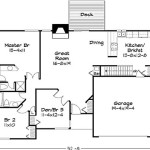How to Make a Home Plan
Creating a home plan is a crucial step in the process of building or renovating a home. It involves meticulously outlining the design, layout, and specifications of your future dwelling, ensuring that it meets your specific needs and preferences. A well-crafted home plan acts as a blueprint for construction, guiding builders and contractors throughout the project. Whether you are designing a small cozy abode or a grand sprawling mansion, a comprehensive plan is indispensable for achieving a successful and satisfying outcome.
1. Define Your Needs and Requirements
Before embarking on the design process, it is essential to clearly define your needs and requirements for your home. This involves considering factors such as:
- Number of bedrooms and bathrooms: This will depend on the size of your family and your lifestyle.
- Living spaces: Determine the different areas you need, such as a living room, dining room, kitchen, family room, home office, and guest rooms.
- Outdoor spaces: Consider the size and layout of your patio, yard, and any other outdoor areas you desire.
- Specific features: Identify any special features you want in your home, such as a fireplace, a walk-in closet, or a swimming pool.
- Budget: Establishing a realistic budget will help you determine the scope of your project and make informed decisions about materials and finishes.
By thoughtfully analyzing your needs and requirements, you can create a plan that aligns with your lifestyle and aspirations.
2. Gather Inspiration and Research
Once you have a clear understanding of your needs, it's time to gather inspiration and conduct research to inform your design choices. Explore various sources for inspiration, such as:
- Architectural magazines and websites: These publications showcase a wide variety of home designs and architectural styles.
- Home design blogs and social media platforms: Explore online communities and platforms dedicated to home design for ideas and inspiration.
- Open houses and model homes: Visiting homes that are open to the public provides a tangible experience of different design layouts and features.
- Home design software: Tools like SketchUp, Floorplanner, and Sweet Home 3D enable you to create virtual 3D models of your home and experiment with different design configurations.
By immersing yourself in various sources of inspiration, you can refine your vision and discover innovative design solutions that resonate with your preferences.
3. Choose a Home Design Style
Selecting a home design style is a key decision that will shape the overall aesthetic and character of your home. Popular architectural styles include:
- Modern: Characterized by clean lines, open layouts, and minimalist décor.
- Traditional: Often features symmetrical facades, intricate details, and classic design elements.
- Contemporary: Embraces a more eclectic approach with a focus on functionality and innovation.
- Mediterranean: Incorporates elements of Spanish and Italian architecture, featuring warm colors, terracotta roofs, and arched doorways.
- Rustic: Utilizes natural materials, exposed beams, and a cozy, inviting atmosphere.
Consider the style that aligns best with your taste and the overall theme and character you envision for your home.
4. Create a Floor Plan
The floor plan is a crucial component of your home plan, as it details the arrangement of rooms, hallways, and other spaces within your home. You can create a floor plan using:
- Manual drafting tools: This traditional method involves using graph paper, pencils, and rulers to draw the plan by hand.
- Home design software: Software programs like those mentioned earlier provide a user-friendly interface for creating floor plans and experimenting with different layouts.
- Online floor plan tools: Many websites offer free or paid tools for creating simple floor plans.
When creating your floor plan, consider factors such as:
- Traffic flow: Design a layout that promotes smooth and efficient movement throughout the home.
- Natural light: Maximize natural light by strategically positioning windows and doors.
- Privacy: Ensure that bedrooms and other private areas offer adequate privacy.
- Functionality: Create spaces that are well-suited for their intended use.
A well-planned floor plan will enhance the functionality, flow, and overall livability of your home.
5. Develop an Elevation Plan
The elevation plan provides a detailed view of the exterior of your home from multiple angles. It showcases the design of the facade, roofline, windows, doors, and other architectural features. Elevation plans are essential for visualizing the overall appearance of your home and ensuring that the exterior design complements the interior layout.
When developing your elevation plan, consider:
- Roof style: Select a roof style that complements the architectural style of your home and suits the local climate.
- Window and door placement: Position windows and doors strategically to maximize natural light and ventilation.
- Exterior materials: Choose materials that are durable, aesthetically pleasing, and match your desired style.
- Landscaping: Consider how landscaping elements can enhance the overall appearance of your home.
A thoughtfully designed elevation plan will create a harmonious and aesthetically pleasing exterior for your home.
6. Create Detail Drawings
Detail drawings provide a more in-depth view of specific elements of your home, such as:
- Wall sections: Show the construction details of walls, including insulation, framing, and finishes.
- Door and window details: Illustrate the dimensions, styles, and hardware of doors and windows.
- Staircase details: Provide detailed information about the construction and design of staircases.
- Kitchen and bathroom layouts: Show the placement of cabinets, appliances, fixtures, and other elements.
Detail drawings are essential for ensuring that the construction of your home is carried out accurately and to your specifications.
7. Review and Refine
Once you have completed your home plan, it is essential to review it thoroughly to ensure that it meets all your needs and requirements. Consider seeking feedback from family members, friends, or a professional architect or designer. This can help you identify any potential issues or areas for improvement before construction begins. It is also important to have your plan approved by local building authorities to ensure that it complies with all applicable codes and regulations.
Creating a home plan is a comprehensive process that requires careful planning, attention to detail, and a thorough understanding of your needs and preferences. By following these steps, you can develop a well-crafted plan that will guide the construction of your dream home.

Floor Plan Creator And Designer Free Easy App

House Plans How To Design Your Home Plan

Floor Plans Learn How To Design And Plan

How To Calculate House Plan Measurements Read Floor Estimate The Dimensions Of Your

Create Floor Plan

1 Bedroom Apartment House Plans

Floor Plan Design Tutorial

How To Make Measurements Home Plan Every People Want Know House Plans Floor Drawing

How To Make Modifications A House Plan

How Do I Build The Best Home In An Area Of 1500 Square Feet 30x50








